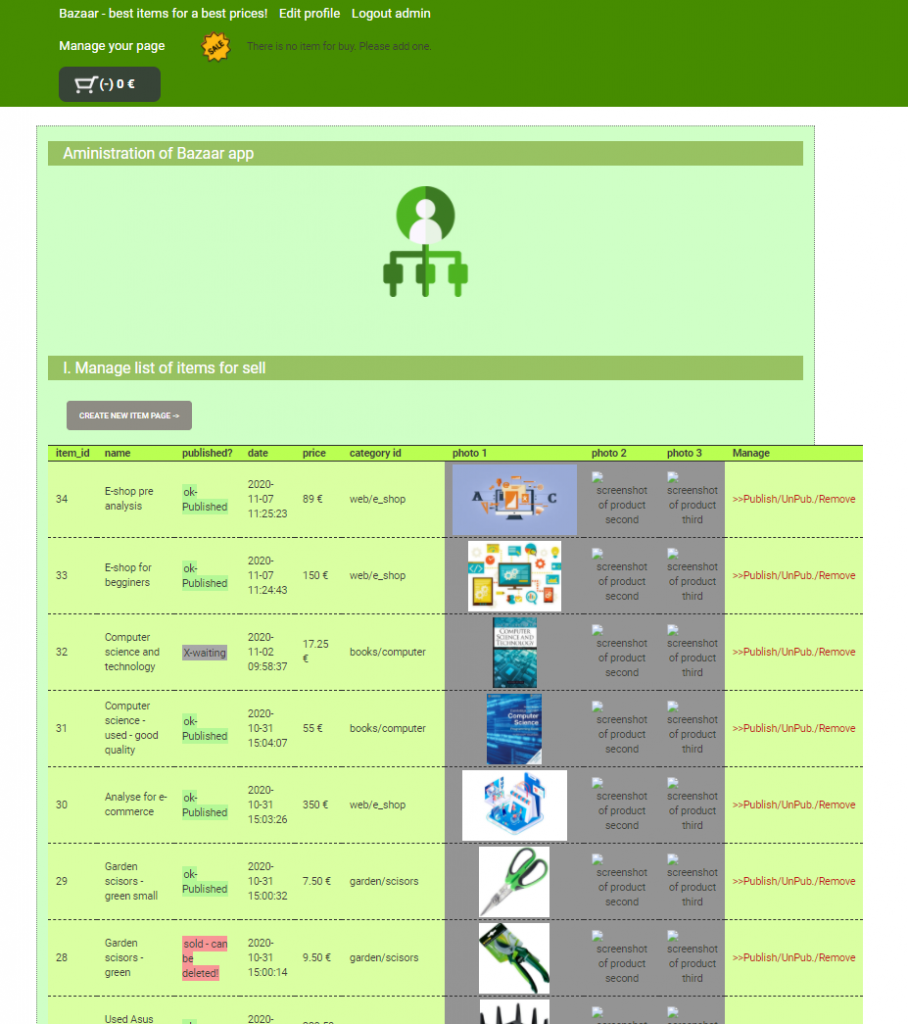Bazaar – php example code – part 14 – handling sold item in database
Article focus on way how to mark sold item in the bazaar_item table for further deletion. Successfully sold item is marked with -1 in cart_number, that is displayed in listing on admin page of bazaar. Admin can see it and delete them. Separate article will focus on way how to order items in lists for better manipulation.
Requirements for item handling
During lifecycle of item we must to manage marking different states of item. When user publish item for sell, item is marked by cart_number field in a database table bazaar_item as 0 and published gain default value of 0 (waiting for admin to make item visible in listening’s).
After admin approval, visible field change its value from 0 to 1. Item now waiting for adding into a cart of buyer. After selecting and adding item into a cart cart_number is changed in to a number representing ID of user that make buy (added item into their own cart).
If usere remove item from cart, cart_number value returns to 0. Another user can add item into a cart and mark them with own ID number.
If user commit cart for final buy, all successfully sold items are marked by -1 in cart_number field.
On admin page, sold item marked with -1 are displayed and after admins decision can be finally removed from a database. Optional functionality for further implementation is option for archiving of soled item by site admin. Another way for automation of removing unused and sold item is creating automated script associated with button for removing any sold item from database table before a some date (as example one month after sold).
Full process of altering of cart_number field is shown on next picture.

In further rows you can see how our page codes handle this changes during whole lifetime of item for sell.
1. sellitem.php – item added for listening
Because default values for fields published and cart_number set to 0. There is no need for any specific write values into a database table. As you can see in next sql statement:
2. cart.php – mark item as sold after successful commit to buy
Cart.php script is responsible for marking cart_number with -1 after successful buy. This is how it is implemented in our code
3. buyitem.php – mark added item into a cart by users ID
When a user add item into a cart, buyitem.php script mark cart_number field with ID of that user. This script work as you now in a two ways. After first call from index.php obtaing get data about item of interest and show info about product of interest, user can chose if will add item into a cart and post submit result on themself. Only post handling part (not get handling part) of code will make operation that is shown in next rows:
4. admin.php – show status of item and give option for deletion
Admin page show items in a database and allow ordering (it will be explained in one of the next articles, how we obtained these functionality).
Next picture show how it looks like without ordering functionality.

Next code snippet show, how are information depicted in published filed in our table:
Adin can now see all itms marked as sold and can manually delete them. For this operation is requested removeitem.php script by clicking link generating link in row manage from upper picture (on admin page). This way is provided call with GET data.
Our removeitem.php script work also as it was mentioned before for buyitem.php in two ways. GET data from calling ling and next submit user decision for removing item from database. For deletion user must change radiobutton from no to yes and submit deletion commit.
Main part enable publishing, unpublishing and deletion of our item. Next code snippet show main logic of this script.
… omitted part of removeitem.php …
Conclusion
We have now a better view on to how is lifecycle of item managed from moment of publishing for sell up to time of removing item from a database.
Now we can see further ways for improvement mostly in last phases of item lifecycle. Our first approach rely on manual handling by site admin, we can add much more automation into a this process by adding code for batch deletion of all sold items or only items sold before a specific time. Other thoughts rely on way how to run script in regulary base without need for intervention. Or how to archive all or only a specific items.
Full application code can be obtained from github from there.


